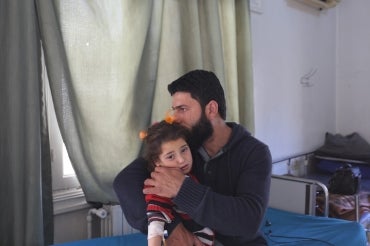Chemical attack in Syria: U of T public health expert talks about Sarin

Published: April 6, 2017
More than 80 people – including dozens of children – were killed in this week's suspected chemical attack in a rebel-held town in northwest Syria.
U.S. President Donald Trump, who has previously argued against removing Syrian President Bashar al-Assad from power, on Wednesday called the attack a “heinous” act that “crossed a lot of lines for me.” Syria and its main backer Russia have denied responsibility.
U of T's Dr. Howard Hu, dean of the Dalla Lana School of Public Health and professor of environmental health, epidemiology, global health and medicine, has led human rights fact-finding missions on the effects of toxic exposures to civilian populations in conflict situations. He is a founding board member of Physicians for Human Rights and served as the director of the Research Commission for the International Physicians for the Prevention of Nuclear War on the health effects of atomic weapon production.
He spoke with U of T's Nicole Bodnar about how chemical weapons like the ones used this week kill victims by suffocating them.
 How do chemical weapons like the ones used in the latest Syrian attack work on the human body?
How do chemical weapons like the ones used in the latest Syrian attack work on the human body?
Sarin, the agent likely used in the latest attack, is a super-potent chemical weapon in the anti-cholinesterase family of poisons that essentially works much like the chemicals used in some of the powerful insecticide products used in the past like Raid, but that are now largely banned for household use in North America.
It attacks the nervous system by interfering with the normal process of degradation of the neurotransmitter acetylcholine at neuromuscular junctions. In other words, instead of the normal process of impulses from nerves activating muscles and then allowing them to relax, the impulses are frozen in an activating phase, causing uncontrollable muscle spasms.
Death will usually occur as a result of asphyxia due to a victim's inability to control the muscles involved in breathing function.
Is there anything from the videos and photo images you’re seeing that can help identify what kind of chemical was used?
The physical signs of pinpoint pupils and foaming at the mouth in some of the photographs are consistent with the marked cholinergic-type chemical effects one would anticipate in victims of a Sarin-related chemical attack.
In your role with Physicians for Human Rights, can you talk about the banning of chemical weapons?
The use of chemical weapons was banned because they are weapons of mass destruction that kill indiscriminately, and there has always been a long-standing public revulsion over the use of science – in this case, chemistry – to kill human beings.
The International Committee for the Red Cross summed up the public horror at the use of such weapons in an appeal in February 1918, calling them “barbarous inventions” that can “only be called criminal.”



